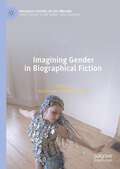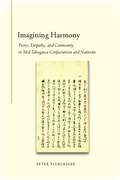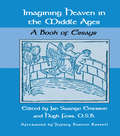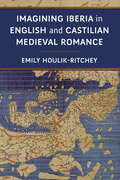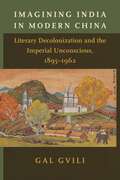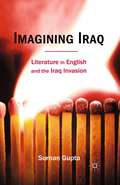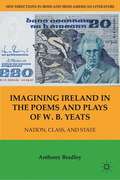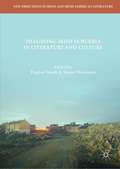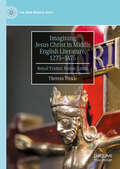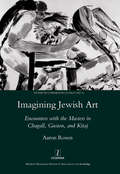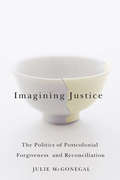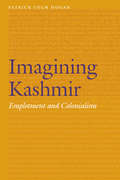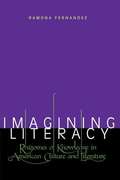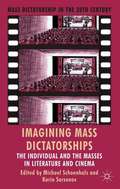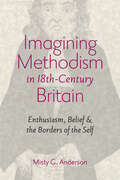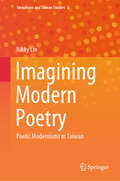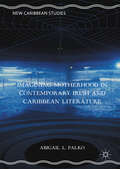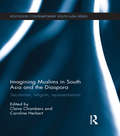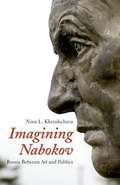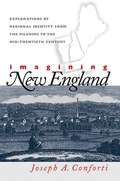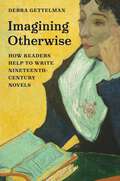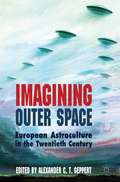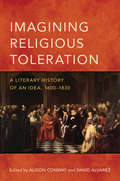- Table View
- List View
Imagining Gender in Biographical Fiction (Palgrave Studies in Life Writing)
by Julia Novak Caitríona Ní DhúillThis volume addresses the current boom in biographical fictions across the globe, examining the ways in which gendered lives of the past become re-imagined as gendered narratives in fiction. Building on this research, this book is the first to address questions of gender in a sustained and systematic manner that is also sensitive to cultural and historical differences in both raw material and fictional reworking. It develops a critical lens through which to approach biofictions as ‘fictions of gender’, drawing on theories of biofiction and historical fiction, life-writing studies, feminist criticism, queer feminist readings, postcolonial studies, feminist art history, and trans studies. Attentive to various approaches to fictionalisation that reclaim, appropriate or re-invent their ‘raw material’, the volume assesses the critical, revisionist and deconstructive potential of biographical fictions while acknowledging the effects of cliché, gender norms and established narratives in many of the texts under investigation. The introduction of this book is available open access under a CC BY 4.0 license at link.springer.com
Imagining Harmony: Poetry, Empathy, and Community in Mid-Tokugawa Confucianism and Nativism
by Peter FlueckigerMany intellectuals in eighteenth-century Japan valued classical poetry in either Chinese or Japanese for its expression of unadulterated human sentiments. They also saw such poetry as a distillation of the language and aesthetic values of ancient China and Japan, which offered models of the good government and social harmony lacking in their time. By studying the poetry of the past and composing new poetry emulating its style, they believed it possible to reform their own society. Imagining Harmonyfocuses on the development of these ideas in the life and work of Ogyu Sorai, the most influential Confucian philosopher of the eighteenth century, and that of his key disciples and critics. This study contends that the literary thought of these figures needs to be understood not just for what it has to say about the composition of poetry but as a form of political and philosophical discourse. Unlike other scholars of this literature, Peter Flueckiger argues that the increased valorization of human emotions in eighteenth-century literary thought went hand in hand with new demands for how emotions were to be regulated and socialized, and that literary and political thought of the time were thus not at odds but inextricably linked.
Imagining Harmony: Poetry, Empathy, and Community in Mid-Tokugawa Confucianism and Nativism
by Peter FlueckigerMany intellectuals in eighteenth-century Japan valued classical poetry in either Chinese or Japanese for its expression of unadulterated human sentiments. They also saw such poetry as a distillation of the language and aesthetic values of ancient China and Japan, which offered models of the good government and social harmony lacking in their time. By studying the poetry of the past and composing new poetry emulating its style, they believed it possible to reform their own society. Imagining Harmonyfocuses on the development of these ideas in the life and work of Ogyu Sorai, the most influential Confucian philosopher of the eighteenth century, and that of his key disciples and critics. This study contends that the literary thought of these figures needs to be understood not just for what it has to say about the composition of poetry but as a form of political and philosophical discourse. Unlike other scholars of this literature, Peter Flueckiger argues that the increased valorization of human emotions in eighteenth-century literary thought went hand in hand with new demands for how emotions were to be regulated and socialized, and that literary and political thought of the time were thus not at odds but inextricably linked.
Imagining Heaven in the Middle Ages: A Book of Essays (Garland Medieval Casebooks)
by Jan Swango Emerson Hugh Feiss O. S. B.First Published in 2000. Routledge is an imprint of Taylor & Francis, an informa company.
Imagining Iberia in English and Castilian Medieval Romance
by Emily Houlik-RitcheyImagining Iberia in English and Castilian Medieval Romance offers a broad disciplinary, linguistic, and national focus by analyzing the literary depiction of Iberia in two European vernaculars that have rarely been studied together. Emily Houlik-Ritchey employs an innovative comparative methodology that integrates the understudied Castilian literary tradition with English literature. Intentionally departing from the standard “influence and transmission” approach, Imagining Iberia challenges that standard discourse with modes drawn from Neighbor Theory to reveal and navigate the relationships among three selected medieval romance traditions. This welcome volume uncovers an overemphasis in prior scholarship on the relevance of “crusading” agendas in medieval romance, and highlights the shared investments of Christians and Muslims in Iberia’s political, creedal, cultural, and mercantile networks in the Mediterranean world.
Imagining India in Modern China: Literary Decolonization and the Imperial Unconscious, 1895–1962
by Gal GviliBeginning in the late Qing era, Chinese writers and intellectuals looked to India in search of new literary possibilities and anticolonial solidarity. In their view, India and China shared both an illustrious past of cultural and religious exchange and a present experience of colonial aggression. These writers imagined India as an alternative to Western imperialism—a Pan-Asian ideal that could help chart an escape route from colonialism and its brutal grasp on body and mind by ushering in a new kind of modernity in Asian terms.Gal Gvili examines how Chinese writers’ image of India shaped the making of a new literature and spurred efforts to achieve literary decolonization. She argues that multifaceted visions of Sino-Indian connections empowered Chinese literary figures to resist Western imperialism and its legacies through novel forms and genres. However, Gvili demonstrates, the Global North and its authority mediated Chinese visions of Sino-Indian pasts and futures. Often reading Indian literature and thought through English translations, Chinese writers struggled to break free from deeply ingrained imperialist knowledge structures.Imagining India in Modern China traces one of the earliest South-South literary imaginaries: the hopes it inspired, the literary rejuvenation it launched, and the shadow of the North that inescapably haunted it. By unearthing Chinese writers’ endeavors to decolonize literature and thought as well as the indelible marks that imperialism left on their minds, it offers new perspective on the possibilities and limitations of anticolonial movements and South-South solidarity.
Imagining Iraq
by Suman GuptaIn the run-up to, during and after the invasion of Iraq a large number of literary texts addressing that context were produced, circulated and viewed as taking a position for or against the invasion, or contributing political insights. This book provides an in-depth survey of such texts to examine what they reveal about the condition of literature.
Imagining Ireland in the Poems and Plays of W. B. Yeats
by Anthony BradleyAn important part of the Irish national imaginary, the poems and plays of W. B. Yeatshave helped to invent the nation of Ireland, while critiquing the modern Irish state that emerged from the nation's revolutionary period. This study offers a chronological account of Yeats's volumes of poetry, contextualizing and analyzing them in light of Irish cultural and political history. "
Imagining Irish Suburbia in Literature and Culture (New Directions In Irish And Irish American Literature )
by Simon Workman Eoghan SmithThis volume explores the literary and visual cultures of modern Irish suburbia, and the historical, social, and aesthetic contexts in which these cultures have emerged.
Imagining Jesus Christ in Middle English Literature, 1275-1475: Royal Traitor, Heroic Lamb (The New Middle Ages)
by Theresa TinkleThis book interprets Jesus Christ as a complicated, disunified literary character in Middle English literature, where he appears variously as king, traitor, victorious conqueror, sacrificial lamb, heroic knight, lover, and spouse--often as several contradictory figures in a single work. These tropes derive from Scripture, doctrines about Christ's two natures, and theories of redemption. This book examines the full range of representations in Southern Passion, Northern Passion, Pepysian Gospel Harmony, Stanzaic Life of Christ, Cursor Mundi, Nicholas Love’s Mirror of the Blessed Life of Jesus Christ, Sir John Mandeville’s Book, the York Play, and Julian of Norwich's Revelation of Love. Although Christ's two natures are well represented in existing scholarship, many traditions have been overlooked, including commonplace treatments of Christ as both a traitor and king, conqueror and sacrificial lamb, hero and lover. As writers call upon audiences to feel compassion for Jesus's suffering, they almost universally express antipathy toward his Jewish torturers, complicating our ideas about affective piety. In these works, the Virgin Mary is less exemplary for her compassion than for her understanding of doctrine. In short, this book offers new perspectives on vernacular Christology between about 1275 and 1475. Theresa Tinkle is a Professor within the Department of English Language and Literature at the University of Michigan, USA, as well as Director of the Gayle Morris Sweetland Center for Writing. Previous publications include Medieval Venuses and Cupids: Sexuality and Hermeneutics in English Poetry (1996) and Gender and Power in Medieval Exegesis (Palgrave, 2010). Theresa’s academic training and publications include the study of medieval English and Latin literature, the medieval reception of the Bible, gender and sexuality studies, paleography and manuscript studies, composition and pedagogy, and disability studies.
Imagining Jewish Art: Encounters with the Masters in Chagall, Guston, and Kitaj
by Aaron RosenShort-listed for the Art and Christian Enquiry/Mercers' International Book Award 2009: 'a book which makes an outstanding contribution to the dialogue between religious faith and the visual arts'. What does modern Jewish art look like? Where many scholars, critics, and curators have gone searching for the essence of Jewish art in Biblical illustrations and other traditional subjects, Rosen sets out to discover Jewishness in unlikely places. How, he asks, have modern Jewish painters explored their Jewish identity using an artistic past which is- by and large - non-Jewish? In this new book we encounter some of the great works of Western art history through Jewish eyes. We see Matthias Grunewald's Isenheim Altarpiece re-imagined by Marc Chagall (1887-1985), traces of Paolo Uccello and Piero della Francesca in Philip Guston (1913-1980), and images by Diego Velazquez and Paul Cezanne studiously reworked by R.B. Kitaj (1932-2007). This highly comparative study draws on theological, philosophical and literary sources from Franz Rosenzweig to Franz Kafka and Philip Roth. Rosen deepens our understanding not only of Chagall, Guston, and Kitaj but also of how art might serve as a key resource for rethinking such fundamental Jewish concepts as family, tradition, and homeland.
Imagining Justice
by Julie McgonegalDrawing on critical and theoretical material by thinkers as diverse as Jacques Derrida, Frantz Fanon, Mahatma Ghandi, and Julia Kristeva, Julie McGonegal supplements indigenous models and approaches with those produced within Euro American discourse. In the process, she develops an understanding of forgiveness and reconciliation based on the interventive power of literature. Through insightful readings of four novels, McGonegal demonstrates the ways in which literature can create the conditions that make processes of postcolonial reconciliation possible.
Imagining Justice: The Politics of Postcolonial Forgiveness and Reconciliation
by Julie McGonegalDrawing on critical and theoretical material by thinkers as diverse as Jacques Derrida, Frantz Fanon, Mahatma Ghandi, and Julia Kristeva, Julie McGonegal supplements indigenous models and approaches with those produced within Euro American discourse. In the process, she develops an understanding of forgiveness and reconciliation based on the interventive power of literature. Through insightful readings of four novels, McGonegal demonstrates the ways in which literature can create the conditions that make processes of postcolonial reconciliation possible.
Imagining Kashmir: Emplotment and Colonialism (Frontiers of Narrative)
by Patrick Colm HoganDuring the 1947 partition of the Indian subcontinent, Kashmir—a Muslim-majority area ruled by a Hindu maharaja—became a hotly disputed territory. Divided between India and Pakistan, the region has been the focus of international wars and the theater of political and military struggles for self-determination. The result has been great human suffering within the state, with political implications extending globally.Imagining Kashmir examines cinematic and literary imaginings of the Kashmir region’s conflicts and diverse citizenship, analyzing a wide range of narratives from writers and directors such as Salman Rushdie, Bharat Wakhlu, Mani Ratnam, and Mirza Waheed in conjunction with research in psychology, cognitive science, and social neuroscience. In this innovative study, Patrick Colm Hogan’s historical and cultural analysis of Kashmir advances theories of narrative, colonialism, and their corresponding ideologies in relation to the cognitive and affective operations of identity. Hogan considers how narrative organizes people’s understanding of, and emotions about, real political situations and the ways in which such situations in turn influence cultural narratives, not only in Kashmir but around the world.
Imagining Literacy: Rhizomes of Knowledge in American Culture and Literature
by Ramona FernandezDefining the "common knowledge" a "literate" person should possess has provoked intense debate ever since the publication of E. D. Hirsch's controversial book Cultural Literacy: What Every American Needs to Know. Yet the basic concept of "common knowledge," Ramona Fernandez argues, is a Eurocentric model ill-suited to a society composed of many distinct cultures and many local knowledges.<P><P>In this book, Fernandez decodes the ideological assumptions that underlie prevailing models of cultural literacy as she offers new ways of imagining and modeling mixed cultural and non-print literacies. In particular, she challenges the biases inherent in the "encyclopedias" of knowledge promulgated by E. D. Hirsch and others, by Disney World's EPCOT Center, and by the Smithsonian Institution. In contrast to these, she places the writings of Zora Neale Hurston, Maxine Hong Kingston, Gloria Anzaldúa, and Leslie Marmon Silko, whose works model a cultural literacy that weaves connections across many local knowledges and many ways of knowing.
Imagining Mass Dictatorships
by Michael Schoenhals Karin SarsenovThis volume in the series Mass Dictatorship in the Twentieth Century series sees twelve Swedish, Korean and Japanese scholars, theorists, and historians of fiction and non-fiction probe the literary subject of life in 20th century mass dictatorships.
Imagining Methodism in Eighteenth-Century Britain: Enthusiasm, Belief, and the Borders of the Self
by Misty G. AndersonIn the eighteenth century, British Methodism was an object of both derision and desire. Many popular eighteenth-century works ridiculed Methodists, yet often the very same plays, novels, and prints that cast Methodists as primitive, irrational, or deluded also betrayed a thinly cloaked fascination with the experiences of divine presence attributed to the new evangelical movement. Misty G. Anderson argues that writers, actors, and artists used Methodism as a concept to interrogate the boundaries of the self and the fluid relationships between religion and literature, between reason and enthusiasm, and between theater and belief. Imagining Methodism situates works by Henry Fielding, John Cleland, Samuel Foote, William Hogarth, Horace Walpole, Tobias Smollett, and others alongside the contributions of John Wesley, Charles Wesley, and George Whitefield in order to understand how Methodism's brand of "experimental religion" was both born of the modern world and perceived as a threat to it.Anderson's analysis of reactions to Methodism exposes a complicated interlocking picture of the religious and the secular, terms less transparent than they seem in current critical usage. Her argument is not about the lives of eighteenth-century Methodists; rather, it is about Methodism as it was imagined in the work of eighteenth-century British writers and artists, where it served as a sign of sexual, cognitive, and social danger. By situating satiric images of Methodists in their popular contexts, she recaptures a vigorous cultural debate over the domains of religion and literature in the modern British imagination. Rich in cultural and literary analysis, Anderson's argument will be of interest to students and scholars of the eighteenth century, religious studies, theater, and the history of gender.
Imagining Modern Poetry: Poetic Modernisms in Taiwan (Sinophone and Taiwan Studies #8)
by Nikky LinThis book offers an in-depth discussion of the evolution of modernist poetry in Taiwan, with a focus on periods preceding and following World War II, and contextualizes the movement within the broader frameworks of Western, Japanese, and Chinese modernism. Through a comparative, dialectical approach, each chapter introduces individual poets and their works to explore key modernist themes such as intellectualism, fudo, pure poetry, translinguistic practice, exile, Cold War cultural ideology, and irony. Despite its significance, Taiwan’s modern poetry has received inadequate scholarly attention within Sinophone language and literature studies; this work aims to address the gap in the literature, offering fresh perspectives and innovative methodological and theoretical frameworks for those interested in Taiwan’s modernist poetic tradition.
Imagining Motherhood in Contemporary Irish and Caribbean Literature (New Caribbean Studies)
by Abigail L. PalkoImagining Motherhood in Contemporary Irish and Caribbean Literature undertakes a comparative transnational reading to develop more expansive literary models of good mothering. Abigail L. Palko argues that Irish and Caribbean literary representations of non-normative mothering practices do not reflect transgressive or dangerous mothering but are rather cultural negotiations of the definition of a good mother. This original book demonstrates the sustained commitment to countering the dominant ideologies of maternal self-sacrifice foundational to both Irish and Caribbean nationalist rhetoric, offering instead the possibility of integrating maternal agency into an effective model of female citizenship.
Imagining Muslims in South Asia and the Diaspora: Secularism, Religion, Representations (Routledge Contemporary South Asia Series)
by Claire Chambers Caroline HerbertLiterary, cinematic and media representations of the disputed category of the ‘South Asian Muslim’ have undergone substantial change in the last few decades and particularly since the events of September 11, 2001. Here we find the first book-length critical analysis of these representations of Muslims from South Asia and its diaspora in literature, the media, culture and cinema. Contributors contextualize these depictions against the burgeoning post-9/11 artistic interest in Islam, and also against cultural responses to earlier crises on the subcontinent such as Partition (1947), the 1971 Indo-Pakistan war and secession of Bangladesh, the 1992 Ayodhya riots , the 2002 Gujarat genocide and the Kashmir conflict. Offering a comparative approach, the book explores connections between artists’ generic experimentalism and their interpretations of life as Muslims in South Asia and its diaspora, exploring literary and popular fiction, memoir, poetry, news media, and film. The collection highlights the diversity of representations of Muslims and the range of approaches to questions of Muslim religious and cultural identity, as well as secular discourse. Essays by leading scholars in the field highlight the significant role that literature, film, and other cultural products such as music can play in opening up space for complex reflections on Muslim identities and cultures, and how such imaginative cultural forms can enable us to rethink secularism and religion. Surveying a broad range of up-to-date writing and cultural production, this concise and pioneering critical analysis of representations of South Asian Muslims will be of interest to students and academics of a variety of subjects including Asian Studies, Literary Studies, Media Studies, Women’s Studies, Contemporary Politics, Migration History, Film studies, and Cultural Studies.
Imagining Nabokov: Russia between Art and Politics
by Nina L. KhrushchevaVladimir Nabokov's "Western choice"--his exile to the West after the 1917 Bolshevik Revolution--allowed him to take a crucial literary journey, leaving the closed nineteenth-century Russian culture behind and arriving in the extreme openness of twentieth-century America. In Imagining Nabokov: Russia Between Art and Politics, Nina L. Khrushcheva offers the novel hypothesis that because of this journey, the works of Russian-turned-American Vladimir Nabokov (1899-1977) are highly relevant to the political transformation under way in Russia today. Khrushcheva, a Russian living in America, finds in Nabokov's novels a useful guide for Russia's integration into the globalized world. Now one of Nabokov's "Western" characters herself, she discusses the cultural and social realities of contemporary Russia that he foresaw a half-century earlier. In Pale Fire;Ada, or Ard Pnin;and other works, Nabokov reinterpreted the traditions of Russian fiction, shifting emphasis from personal misery and communal life to the notion of forging one's own "happy" destiny. In the twenty-first century Russia faces a similar challenge, Khrushcheva contends, and Nabokov's work reveals how skills may be acquired to cope with the advent of democracy, capitalism, and open borders.
Imagining New England
by Joseph A. ConfortiSay "New England" and you likely conjure up an image in the mind of your listener: the snowy woods or stone wall of a Robert Frost poem, perhaps, or that quintessential icon of the region--the idyllic white village. Such images remind us that, as Joseph Conforti notes, a region is not just a territory on the ground. It is also a place in the imagination. This ambitious work investigates New England as a cultural invention, tracing the region's changing identity across more than three centuries. Incorporating insights from history, literature, art, material culture, and geography, it shows how succeeding generations of New Englanders created and broadcast a powerful collective identity for their region through narratives about its past. Whether these stories were told in the writings of Frost or Harriet Beecher Stowe, enacted in historical pageants or at colonial revival museums, or conveyed in the pages of a geography textbook or Yankee magazine, New Englanders used them to sustain their identity, revising them as needed to respond to the shifting regional landscape.
Imagining Otherwise: How Readers Help to Write Nineteenth-Century Novels
by Debra GettelmanHow Victorian authors engaged the imaginations of their readers and elevated the novel to new heightsAs novel publication exploded in nineteenth-century Britain, writers such as Jane Austen, Charles Dickens, and George Eliot learned from experience—sometimes grudgingly—that readers tend to make their own imaginative contributions to fictional worlds. Imagining Otherwise shows how Victorian writers acknowledged, grappled with, and ultimately enlisted the prerogative of readers to conjure alternatives and add depth to the words on the page.Debra Gettelman provides incisive new readings of novels such as Sense and Sensibility, Little Dorrit, and Middlemarch, exploring how novelists known for prescriptive and didactic narrative voices were at the same time exploring the aesthetic potential for the reader&’s independent imagination to lend nuance and authenticity to fiction. Modernist authors of the twentieth century have long been considered pioneers in cultivating the reader&’s capacity to imagine what is not said as part of the art of fiction. Gettelman uncovers the roots of this tradition of novel reading a century earlier and challenges literary criticism that dismisses this spontaneous, readerly impulse as being unworthy of serious examination.As readers demand novels with relatable characters and fan fiction grows in popularity, the reader&’s imagination has become a determining element of today&’s literary environment. Imagining Otherwise takes a deeper look at this history, offering a critical perspective on how we came to view fiction as a site of imaginative appropriation.
Imagining Outer Space: European Astroculture in the Twentieth Century (Palgrave Studies in the History of Science and Technology)
by Alexander C.T. GeppertImagining Outer Space makes a captivating advance into the cultural history of outer space and extraterrestrial life in the European imagination. How was outer space conceived and communicated? What promises of interplanetary expansion and cosmic colonization propelled the project of human spaceflight to the forefront of twentieth-century modernity? In what way has West-European astroculture been affected by the continuous exploration of outer space? Tracing the thriving interest in spatiality to early attempts at exploring imaginary worlds beyond our own, the book analyzes contact points between science and fiction from a transdisciplinary perspective and examines sites and situations where utopian images and futuristic technologies contributed to the omnipresence of fantasmatic thought. Bringing together state-of-the-art work in this emerging field of historical research, the volume breaks new ground in the historicization of the Space Age.
Imagining Religious Toleration: A Literary History of an Idea, 1600–1830
by Alison Conway David AlvarezFormerly a site of study reserved for intellectual historians and political philosophers, scholarship on religious toleration, from the perspective of literary scholars, is fairly limited. Largely ignored and understudied techniques employed by writers to influence cultural understandings of tolerance are rich for exploration. In investigating the eighteenth-century novel, Alison Conway, David Alvarez, and their contributors shed light on what literature can say about toleration, and how it can produce and manage feelings of tolerance and intolerance. Beginning with an overview of the historical debates surrounding the terms "toleration" and "tolerance," this book moves on to discuss the specific contributions that literature and literary modes have made to cultural history, studying the literary techniques that philosophers, theologians, and political theorists used to frame the questions central to the idea and practice of religious toleration. Tracing the rhetoric employed by a wide range of authors, the contributors delve into topics such as conversion as an instrument of power in Shakespeare; the relationship between religious toleration and the rise of Enlightenment satire; and the ways in which writing can act as a call for tolerance.
